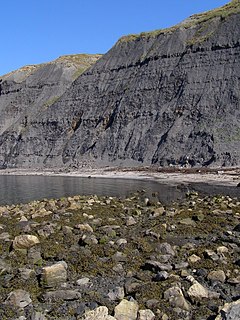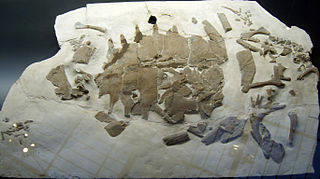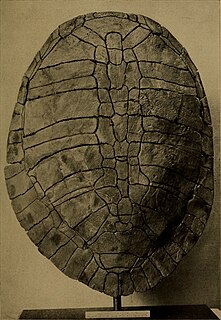
Proganochelys is an extinct, primitive stem-turtle that has been hypothesized to be the sister taxon to all other turtles creating a monophyletic group, the Casichelydia. Proganochelys was named by Georg Baur in 1887 as the oldest turtle in existence at the time. The name Proganochelys comes from the Greek word ganos meaning brightness, combined with prefix pro, and Greek base chelys meaning "turtle". Proganochelys is believed to have been around 1 meter in size and herbivorous in nature. Proganochelys was known as the most primitive stem-turtle for over a century, until the novel discovery of Odontochelys in 2008. Odontochelys and Proganochelys share unique primitive features that are not found in Casichelydia, such as teeth on the pterygoid and vomer and a plate-like coracoid.

The Kimmeridge Clay is a sedimentary deposit of fossiliferous marine clay which is of Late Jurassic to lowermost Cretaceous age and occurs in southern and eastern England and in the North Sea. This rock formation is the major source rock for North Sea oil. The fossil fauna of the Kimmeridge Clay includes turtles, crocodiles, sauropods, plesiosaurs, pliosaurs and ichthyosaurs, as well as a number of invertebrate species.

Paracryptodira is an extinct group of reptiles in the clade Testudinata, known from the Jurassic to Paleogene of North America and Europe. Initially treated as a suborder sister to Cryptodira, they were then thought to be a very primitive lineage inside the Cryptodira according to the most common use of the latter taxon. They are now often regarded as late-diverging stem-turtles, lying outside the clade formed by Cryptodira and Pleurodira. The paracryptodires are said to have phylogenic relationships, noted as primary subclades, within the Baenidae and Pleurosternidae. Within each subclade, lies many biodiverse turtles that are continuously being investigated and added to the fossil record. Paracryptodires are divided into 3 main groups, Compsemydidae, known from the Late Jurassic to Paleocene of North America and Europe, Pleurosternidae, known from the Late Jurassic to Early Cretaceous of North America and Europe, and Baenidae, known from the Early Cretaceous to Eocene of North America. The latter two groups are more closely related to each other than to Compsemys, forming the clade Baenoidea.

Thalassemys is a genus of extinct thalassochelydian turtle from the Late Jurassic of western and central Europe. While the genus was originally named by Rütimeyer in 1859 for a large carapace and other associated fragments from the late Kimmeridgian of the Reuchenette Formation of Switzerland, although the taxon was not validly named until 1873 when Rütimeyer designated the type species T. hugii. Rütimeyer also named T. gresslyi from the Reunchenette Formation in the same paper as T. hugii, but it cannot be differentiated from the type material of T. hugii and is therefore a junior synonym. A large assemblage of shell and postcranial material from the Reunchenette was named as a species of Eurysternum, E. ignoratum, by Bräm in 1965. While originally distinguished based on the presence of fontanelles on the plastron, the feature was later identified on T. hugii and E. ignoratum was designated a junior synonym. Additional material from the Kimmeridge Clay of the United Kingdom has also been referred to T. hugii.

Eurysternum is an extinct genus of thalassochelydian turtle. Its type species is Eurysternum wagleri, the holotype of which has since been lost and only survives in illustrations.
Compsemys is an extinct genus of prehistoric turtles from the Late Cretaceous and Paleocene of North America and possibly Europe. The type species C. victa, first described by Joseph Leidy from the Hell Creek Formation in Montana in 1856., and another probable species C. Russelli, described in 2012, from Paleocene deposits in France. Its affinites have long been uncertain, but it has recently been considered to be the most basal member of Paracryptodira, despite the clade first appearing in the Late Jurassic, and is sometimes included in its own family, Compsemydidae. A revision in 2020 found Compsemydidae to be more expansive, also containing Riodevemys and Selenemys from the Late Jurassic of Europe, and Peltochelys from the Early Cretaceous of Europe.

Pleurosternon is an extinct genus of freshwater pleurosternid turtle from the late Jurassic period to the early Cretaceous period of Europe. Its type species, P. bullocki was described by the paleontologist Richard Owen in 1853. Since then, and throughout the late 19th century, many fossil turtles were incorrectly assigned to this genus, though only two are currently considered valid.
Hispaniachelys is an extinct genus of thalassochelydian turtle known from the Lorente Formation of southern Spain. Reinterpretation of the original material shows that the taxon lacks diagnostic characteristics and is thus a nomen dubium.

Palaeomedusa testa is an extinct species of thalassochelydian turtle from the Tithonian of the Late Jurassic. It was first described by the German palaeontologist Christian Erich Hermann von Meyer in 1860. It is the only species classified under the genus Palaeomedusa.

Eurysternidae is an extinct family of turtles in the clade Thalassochelydia. It consists of several genera of marine turtles from marine deposits in Europe, including Achelonia, Chelonides, Eurysternum. Hydropelta, Chelonides, Idiochelys, Palaeomedusa, Parachelys. and Solnhofia.

Macrobaenidae is an extinct family of turtles, known from the Early Cretaceous to Paleogene of Laurasia. Their relationships to other turtles and whether or not they form a monophlyletic group are controversial. Initially they were intepreted as stem or crown group cryptodires, but some more recent analyses have found them to lie outside crown group Testudines. Macrobaenids can be distinguished from other testudinatans by the presence of a carotid fenestra, cruciform plastron with strap-like epiplastra, and a lack of extragulars.
Achelonia is an extinct genus of marine thalassochelydian turtle. Its type species is Achelonia formosa. Fossils are known from the Upper Jurassic of Wattendorf, Germany, Cerin, France, and England. Material from England was originally considered to belong to the separate genus Enaliochelys and species Enaliochelys chelonia, named by Harry Govier Seeley in 1869 for a partial disarticulated skeleton from the early Kimmeridgian of the Kimmeridge Clay in Cambridgeshire. The synonymy was recognised in 2020.
Chelonides is a genus of late Jurassic turtle from marine deposits in Lower Saxony, Germany.

Idiochelys is a genus of Late Jurassic turtle from marine deposits in the Jura Mountains of eastern France and Bavaria, Germany.

Mesochelydia is a clade within Pantestudines, more inclusive than Perichelydia, but less than Testudinata. The clade is known from the Early Jurassic to the Present, and contains all Jurassic representatives of Testudinata aside from Australochelys. The ancestral condition for Mesochelydia is thought to be aquatic, as opposed to terrestrial for Testudinata. They are distinguished from more basal testudinatans by the presence of the following characters: strap like pectoral girdle, supramarginals absent, reduced posterior entoplastral process, eleven pairs of peripherals, elongate processus interfenestralis, paired basioccipital tubercles, fully formed cavum tympani and antrum postoticum, single vomer, confluent external nares, lacrimals and supratemporals absent.

Thalassochelydia is a clade of extinct marine turtles from the Late Jurassic and earliest Cretaceous of Europe and South America. The group is defined as including Eurysternum, Plesiochelys and Thalassemys to the exclusion of Pelomedusa, Testudo and Protostega. While a clade uniting the families Eurysternidae, Plesiochelyidae and Thalassemydidae had been supported by phylogenetic evidence, a name was not given for the clade until 2017, when Jérémy Anquetin and colleagues coined Thalassochelydia.

Solnhofia is a genus of extinct thalassochelydian turtle from the Late Jurassic of Germany. The type species is Solnhofia parsoni, named by Gaffney in 1975 for a partial skull and jaw from the early Tithonian of the Solnhofen Formation in Bavaria. Additional material including a complete skeleton is known from the late Kimmeridgian of Switzerland and the Kimmeridgian/Tithonian of other deposits within Bavaria, and potentially also unprepared material from the Late Jurassic of France. The genus was referred to the family Eurysternidae by Anquetin and colleagues in 2017, which may represent an artificial grade of early thalassochelydians. In 2020 a new species Solnhofia brachyrhyncha was described from the Kimmeridigan aged Reuchenette Formation of Switzerland.
Aplax is a dubious genus of extinct thalassochelydian turtle from the Late Jurassic of Germany. The type and only species is Aplax oberndorferi, named by Hermann von Meyer in 1843 for a complete juvenile skeleton from the early Tithonian of the Solnhofen Formation in Bavaria. Despite being aware that shell morphology changes during growth, Meyer named Aplax due to his consideration it represented a relative of Dermochelys, where the adults lack distinction of shell regions as in Aplax. However the taxon was later referred to Thalassochelydia by Anquetin and colleagues in 2017, and due to the loss of the original holotype it cannot be identified as a distinct taxon of a juvenile of existing Solnhofen turtles and is therefore a nomen dubium.
Euryaspis is a dubious genus of extinct thalassochelydian turtle from the Late Jurassic of Germany. The type and only species is Euryaspis radians, originally proposed by Wagner in 1859 before being validly described and illustrated in 1861. The only specimen was a partial carapace probably from the Tithonian, although the original locality is unknown. The genus is referred to Thalassochelydia and has been considered a synonym of Eurysternum or Acichelys before, but casts that remain of the lost holotype show that it bears no features that can clarify its validity making it a nomen dubium.
Owadowia is a genus of extinct thalassochelydian turtle from the Late Jurassic of Poland. The type and only species is Owadowia borsukbialynickae, named by Szczygielski and colleagues in 2017 for a partial lower jaw, coracoid, ilium and femur from the early Tithonian Kcynia Formation. The limited material means that it is difficult to compare Owadowia to its relatives, and it may not be a unique taxon. The genus lacks the features diagnostic to its parent clade Thalassochelydia, has similarities to Solnhofia and Portlandemys as well as being a Late Jurassic marine turtle like the remainder of the group.













